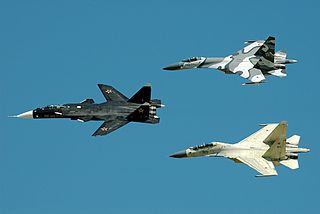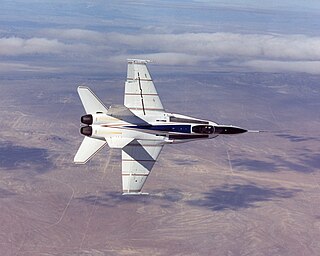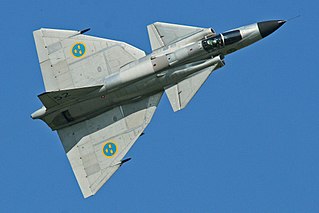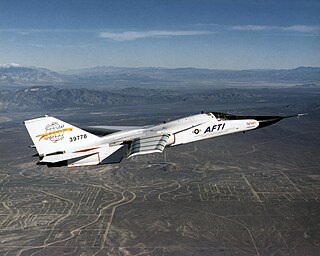
A swept wing is a wing angled either backward or occasionally forward from its root rather than perpendicular to the fuselage.

The Bell X-5 was the first aircraft capable of changing the sweep of its wings in flight. It was inspired by the untested wartime P.1101 design of the German Messerschmitt company. In contrast with the German design, which could only have its wing sweepback angle adjusted on the ground, the Bell engineers devised a system of electric motors to adjust the sweep in flight.

The Rockwell-Messerschmitt-Bölkow-Blohm X-31 is an experimental jet aircraft designed to test fighter thrust vectoring technology.

The Sukhoi Su-47 Berkut, also designated S-32 and S-37 during initial development, was a Russian experimental supersonic jet fighter developed by the JSC Sukhoi Company. A distinguishing feature of the aircraft was its forward-swept wing which gave the aircraft excellent agility and maneuverability. While serial production of the type never materialized and the configuration was not further pursued, the sole aircraft produced served as a technology demonstrator prototype for a number of advanced technologies later used in the 4.5 generation fighter Su-35 and current fifth-generation jet fighter Su-57.

Elevators are flight control surfaces, usually at the rear of an aircraft, which control the aircraft's pitch, and therefore the angle of attack and the lift of the wing. The elevators are usually hinged to the tailplane or horizontal stabilizer. They may be the only pitch control surface present, and are sometimes located at the front of the aircraft or integrated into a rear "all-moving tailplane", also called a slab elevator or stabilator.

The Grumman XF10F Jaguar was a prototype swing-wing fighter aircraft offered to the United States Navy in the early 1950s. Although it never entered service, its research paved the way toward the later General Dynamics F-111 and Grumman's own F-14 Tomcat.

A forward-swept wing or reverse-swept wing is an aircraft wing configuration in which the quarter-chord line of the wing has a forward sweep. Typically, the leading edge also sweeps forward.

An aircraft stabilizer is an aerodynamic surface, typically including one or more movable control surfaces, that provides longitudinal (pitch) and/or directional (yaw) stability and control. A stabilizer can feature a fixed or adjustable structure on which any movable control surfaces are hinged, or it can itself be a fully movable surface such as a stabilator. Depending on the context, "stabilizer" may sometimes describe only the front part of the overall surface.

In aerodynamics, pitch-up is an uncommanded nose-upwards rotation of an aircraft. It is an undesirable characteristic that has been observed mostly in experimental swept-wing aircraft at high subsonic Mach numbers or high angle of attack.

The NASA AD-1 was both an aircraft and an associated flight test program conducted between 1979 and 1982 at the NASA Dryden Flight Research Center, Edwards California, which successfully demonstrated an aircraft wing that could be pivoted obliquely from zero to 60 degrees during flight.

The X-53 Active Aeroelastic Wing (AAW) development program is a completed American research project that was undertaken jointly by the Air Force Research Laboratory (AFRL), Boeing Phantom Works and NASA's Dryden Flight Research Center, where the technology was flight tested on a modified McDonnell Douglas F/A-18 Hornet. Active Aeroelastic Wing Technology is a technology that integrates wing aerodynamics, controls, and structure to harness and control wing aeroelastic twist at high speeds and dynamic pressures. By using multiple leading and trailing edge controls like "aerodynamic tabs", subtle amounts of aeroelastic twist can be controlled to provide large amounts of wing control power, while minimizing maneuver air loads at high wing strain conditions or aerodynamic drag at low wing strain conditions. This program was the first full-scale proof of AAW technology.
An adaptive compliant wing is a wing which is flexible enough for aspects of its shape to be changed in flight. Flexible wings have a number of benefits. Conventional flight control mechanisms operate using hinges, resulting in disruptions to the airflow, vortices, and in some cases, separation of the airflow. These effects contribute to the drag of the aircraft, resulting in less efficiency and higher fuel costs. Flexible aerofoils can manipulate aerodynamic forces with less disruptions to the flow, resulting in less aerodynamic drag and improved fuel economy.

In aeronautics, a canard is a wing configuration in which a small forewing or foreplane is placed forward of the main wing of a fixed-wing aircraft or a weapon. The term "canard" may be used to describe the aircraft itself, the wing configuration, or the foreplane. Canard wings are also extensively used in guided missiles and smart bombs.

In aeronautics, a tailless aircraft is an aircraft with no other horizontal aerodynamic surface besides its main wing. It may still have a fuselage, vertical tail fin, and/or vertical rudder.
Supermaneuverability is the capability of fighter aircraft to execute tactical maneuvers that are not possible with purely aerodynamic techniques. Such maneuvers can involve controlled side-slipping or angles of attack beyond maximum lift.

The wing configuration of a fixed-wing aircraft is its arrangement of lifting and related surfaces.

In aviation, a strake is an aerodynamic surface generally mounted on the fuselage of an aircraft to improve the flight characteristics either by controlling the airflow or by a simple stabilising effect.

A three-surface aircraft or sometimes three-lifting-surface aircraft has a foreplane, a central wing and a tailplane. The central wing surface always provides lift and is usually the largest, while the functions of the fore and aft planes may vary between types and may include lift, control and/or stability.

The General Dynamics–Boeing AFTI/F-111A Aardvark was a research aircraft modified from a General Dynamics F-111 Aardvark to test a Boeing-built supercritical mission adaptive wing (MAW). This MAW, in contrast to standard control surfaces, could smoothly change the shape of its airfoil in flight.






















